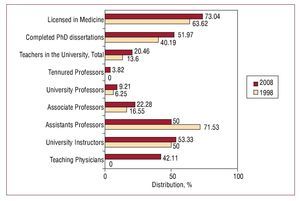To the Editor,
We were extremely interested in the letter by González-Alcaide et al1 regarding the role that women have played in Spanish cardiology research in recent years.
This study's efforts make up in part for the scarcity of reliable statistical data broken down by sex, which is a fundamental matter if we are to obtain an adequate view of both the actual situation and the changes that are occurring, and analyse the results.
According to González-Alcaide et al, 26.98% of authors for the study period are women; examined by volume, women made up only 4.08% of the authors with 9 publications or more. The authors attribute this poor representative showing to negative attitudes on a psychological level.1 However, the reasons behind this situation have been subjected to in-depth study in the European Union's ETAN report.2 Therefore, line graphs like the one shown1 reflect the impact of sex on the results of scientific programmes of study. The separation of the data for the two cohorts, with a rising line for males and a falling line for females, is the result of the most significant interruptions to the professional career which occur around and after age thirty; women tend to be more susceptible than men and postpone their period of maximum scientific productivity and its related possibilities for professional promotion.2
On the other hand, our attention is drawn to the 5% increase in the number of authors and contributors, which is extremely important considering that only 16% of our cardiologists are women, and have higher participation percentages than those seen in some countries.2 This fact reflects a feminising tendency in the profession; more than 40% of the new residents each year are women, which will change the Spanish cardiology population pyramid, which is currently male-dominated with an advanced mean age.3 However, this "supply argument" (referring to the gradual incorporation of women into the professional lifestyle) does not completely explain the current situation, as demonstrated by a recent study that analysed the distribution of heads of service in Catalonian hospitals.4 According to INE data5 (Figure), the percentage of women studying medicine in 2008 is slightly higher than that in 1998; 10 years later, 40% of the female PhDs at that time currently occupy 50% of the assistant professorships, but only 9.2% are full professors. The scarceness of women in leading positions in scientific production has also been analysed in the United States, and it has been attributed to sociological barriers with pre-assigned roles and demands that are incompatible with family responsibilities.6 Lastly, despite the fact that women have entered nearly all of the traditionally male-dominated professional fields, few reach leadership positions although there are no identifiable reasons explaining this fact; in sociology, this is known as the "glass ceiling."
Figure 1.Percentage of female university instructors of Medicine in 1998 and 2008. Source: Spanish National Institute of Statistics.
To conclude, we must consider the organisation of scientific programmes of study and research to be a product of society, its values, and its organisation.2 For that reason, the Fifth European Union Framework Programme refers to equal treatment, positive action and mainstreaming policies that are designed to make the most of people's scientific potential whilst treating men and women equally.
Acknowledgements. Many thanks to Dr Isabel Diz, former Director of the Office of Equality at the University of Santiago de Compostela, and to Dr Marta Lois at the Faculty of Political Science at the University of Santiago de Compostela for assisting in the preparation of this article.


